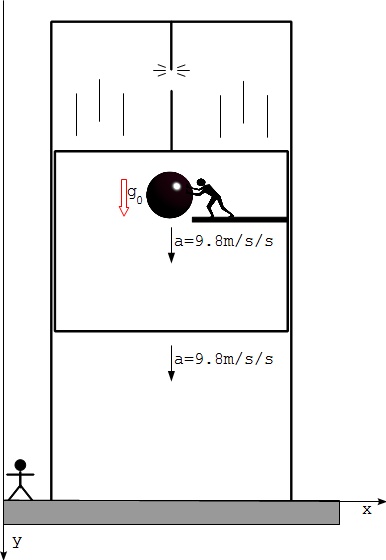Physics Notes - Herong's Tutorial Notes - v3.25, by Herong Yang
Falling Ball in Earth Frame of Reference
This section provides an example of a falling ball in the Earth frame of reference, where we need to add the gravitational force to make Newton's First and Second Laws of Motion valid.
Note that Newton's First and Second Laws of Motion are directly related to the frame of reference. Consider the following example of a falling ball in the Earth frame of reference:
A man with a ball is in an elevator. The elevator cable breaks. The man falls down with the elevator. While falling down, he pushes out ball to try to drop it.
Then we set a frame of reference on the ground and observer the motion of the ball, we will see the following:
- There is no force in the vertical direction acted on the ball.
- The ball is moving down vertically with an acceleration of 9.8 m/s/s.
So Newton's First and Second Laws of Motion seem to be invalid here. In order to make them valid, Newton introduced the gravitational force - Earth always exerts a force (9.8 newton/kg) on every object toward the center of Earth at the sea level.
With this gravitational force added to the frame of reference that fixed to the Earth surface, Newton's First and Second Laws of Motion are valid now: The ball has a downward acceleration (9.8 m/s/s), because there is a downward gravitational force (9.8 newton/kg) acted on it by the earth.

Table of Contents
Introduction of Frame of Reference
►Falling Ball in Earth Frame of Reference
Falling Ball in Elevator Frame of Reference
Introduction of Special Relativity
Time Dilation in Special Relativity
Length Contraction in Special Relativity
The Relativity of Simultaneity
Minkowski Spacetime and Diagrams
Introduction of Generalized Coordinates